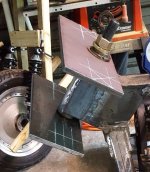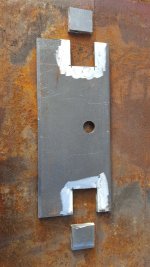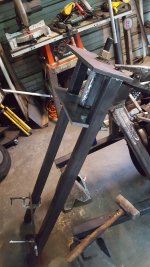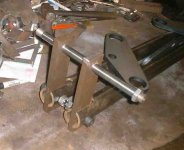Navigation
Install the app
How to install the app on iOS
Follow along with the video below to see how to install our site as a web app on your home screen.
Note: This feature may not be available in some browsers.
More options
You are using an out of date browser. It may not display this or other websites correctly.
You should upgrade or use an alternative browser.
You should upgrade or use an alternative browser.
88 blazer trike
- Thread starter Fowler
- Start date
vwbug72501
700+ Posts
The other thing to remember when using any kind of hole saw is to use a drill press (or mill drill) with a stout quill assembly and position your work so the quill has to move out of the head as little as possible to do the job. The rigidity is in the head support. I've even had success with the Milwaukee hole saw (designed for metal applications) for the occasional one-off hole.
Marc H
4250+ Posts
You might look at seal like my 07 Vulcan uses in the stem.It basically gets tightened between the bearing and top plate.The rotation is between the seal and neck.The seal lips are on the outside of the seal.
- Thread starter
- #365
Bob,
I've been following this thread and had an idea that I thought I'd throw out there.
View attachment 52274
You could add an oil seal to the top and bottom Triple Tree plates by welding on a piece of tubing with an ID equal to the OD of the seal you would use and turn and polish the OD of the neck piece equal to the ID of the seal. The picture is a little blurry, sorry.
Looks like this would seal up the whole neck bearing area.
Never tried this. Just a thought.
Looking back I like this ides the most (with some modifications)
I would actually have the bottom ring welded to the neck with the opening at the bottom
- Thread starter
- #366
Tomorrow I get to work on the trike in the morning but have to paint in the afternoon.
Will start with my plates
I need to drill holes through the top plate at the X, no problem as long as I get them in the correct place
I also need to take a 2" square notch out of each side of the bottom plate
Cutting the sides of the notch will not be an issue. Its the inside cut that will be a pain.

Question????
On the neck itself do I put a grease fitting? I did not do that on my last 2 trikes.
Will start with my plates
I need to drill holes through the top plate at the X, no problem as long as I get them in the correct place
I also need to take a 2" square notch out of each side of the bottom plate
Cutting the sides of the notch will not be an issue. Its the inside cut that will be a pain.

Question????
On the neck itself do I put a grease fitting? I did not do that on my last 2 trikes.
LarryA
500+ Posts
I did not. actually never gave it a thought....just saying you wanted to...would you need 2 internal seals ,stem bolt to neck id? otherwise filling entire area with grease seems wasteful?
- Thread starter
- #368
I did not. actually never gave it a thought....just saying you wanted to...would you need 2 internal seals ,stem bolt to neck id? otherwise filling entire area with grease seems wasteful?
right without those seals it would leak out the bottom on hot days
Not sure on the type of seals I will use if any yet
- Thread starter
- #369
it was easy to cut

tacked in place, Need to mark the location for the pivot holes. Then take the down tubes back off and cut the holes.
Will go 1 inch below the axle height as you guys recommended
Both tubes are at 35 degrees same as the neck
the outside width on top and bottom measures 14"
Now that I made it wider I am not sure my axle bolt will be long enough. If I need to I will buy a new one.


tacked in place, Need to mark the location for the pivot holes. Then take the down tubes back off and cut the holes.
Will go 1 inch below the axle height as you guys recommended
Both tubes are at 35 degrees same as the neck
the outside width on top and bottom measures 14"
Now that I made it wider I am not sure my axle bolt will be long enough. If I need to I will buy a new one.

- Thread starter
- #370
LarryA
500+ Posts
maybe use bronze/ nylon/ teflon/etc. shouldered bushings...or shouldered spacers? to keep from steel to steel interference.
or plastic /bronze flat washers that fit over the pivot bushings to take up the side clearance.
or plastic /bronze flat washers that fit over the pivot bushings to take up the side clearance.
- Thread starter
- #372
maybe use bronze/ nylon/ teflon/etc. shouldered bushings...or shouldered spacers? to keep from steel to steel interference.
or plastic /bronze flat washers that fit over the pivot bushings to take up the side clearance.
That was what I was thinking but I see forks built without them (like the one in the pitcher) and was wondering if they are needed.
LarryA
500+ Posts
All I had for washers was a dab of grease......probably long gone....LOL
vwbug72501
700+ Posts
Here's the question: How many hundreds of thousands of miles do you plan to ride? Thrust washers will add longevity.
I'm assuming that you are planning to plug the bottom of the tubes where the rockers will pivot. What are the expected maximum angles of deflection for the rockers? Probably won't translate to too much metal to metal movement at the rocker / down tube junction. Actually the rocker bushings and bolts should take the side loads and minimize the side deflection. You can probably go back after the assembly is completed and clearance the slots slightly to minimize the contact with no loss of strength.
Google bronze thrust washers and see what's available. You could incorporate the additional thickness of 2 washers in your design and fabrication if you're really concerned.
I'm assuming that you are planning to plug the bottom of the tubes where the rockers will pivot. What are the expected maximum angles of deflection for the rockers? Probably won't translate to too much metal to metal movement at the rocker / down tube junction. Actually the rocker bushings and bolts should take the side loads and minimize the side deflection. You can probably go back after the assembly is completed and clearance the slots slightly to minimize the contact with no loss of strength.
Google bronze thrust washers and see what's available. You could incorporate the additional thickness of 2 washers in your design and fabrication if you're really concerned.
- Thread starter
- #375
I was just looking at a few designs and not a lot of them do not use bushings. (some do)
1 I seen has no bushings but does have a grease fitting on each rocker at the pivot point.
I am kind of torn between what I want to do. I don't mind putting in bronze bushings but if they are not needed I would rather not. I want to keep it as simple as I can and still have a reliable front end.
I need to do some more research before I move foward on that
1 I seen has no bushings but does have a grease fitting on each rocker at the pivot point.
I am kind of torn between what I want to do. I don't mind putting in bronze bushings but if they are not needed I would rather not. I want to keep it as simple as I can and still have a reliable front end.
I need to do some more research before I move foward on that
I was just looking at a few designs and not a lot of them do not use bushings. (some do)
1 I seen has no bushings but does have a grease fitting on each rocker at the pivot point.
I am kind of torn between what I want to do. I don't mind putting in bronze bushings but if they are not needed I would rather not. I want to keep it as simple as I can and still have a reliable front end.
I need to do some more research before I move foward on that
for me the bushing worth the effort...steel on steel something will wear.. bronze or similar will wear before the steel... an can be replaced
peteg59
Meme Master
My $.02 Bob:
The advantage of having a front end with bushings is that the "parent" metal in theory won't suffer any wear coming from the natural shocks/normal travel from the road. (provided you monitor it occasionally, and don't push it too far after the bushings wear points)
Without bushings the rocker and/or whatever component that the rockers are mounted to could also both wear unevenly, (egg shaping the mount holes), depending on how often you ride it.
You could build it without bushings and see how it wears after a season or so depending how often and miles you ride?
If you plan on riding the trike other than taking out out to show on occasion, and want to reduce the maintenance downtime in having to "rebuild" the parts you made, bite the bullet now and go bronze bushings with zerk fittings for occasional lubrication...
The advantage of having a front end with bushings is that the "parent" metal in theory won't suffer any wear coming from the natural shocks/normal travel from the road. (provided you monitor it occasionally, and don't push it too far after the bushings wear points)
Without bushings the rocker and/or whatever component that the rockers are mounted to could also both wear unevenly, (egg shaping the mount holes), depending on how often you ride it.
You could build it without bushings and see how it wears after a season or so depending how often and miles you ride?
If you plan on riding the trike other than taking out out to show on occasion, and want to reduce the maintenance downtime in having to "rebuild" the parts you made, bite the bullet now and go bronze bushings with zerk fittings for occasional lubrication...
LarryA
500+ Posts
every time the front end hits tar strips, rumble strips, washboards if on gravel roads, I wonder.....how are my bushings holding up....glad I have them. got a bunch of extras in the drawer too.
Welcome to the Trike Talk Community
Join our vibrant online community dedicated to all things Trikes! Whether you're a seasoned rider or just starting out, this is the place to share experiences, tips, and stories about your three-wheeled adventures. Explore modifications, maintenance advice, and rides, all while connecting with fellow trike enthusiasts from around the globe
Trike Talk Community
Welcome to a community dedicated to the most diverse and fastest growing powersports segment, Motorcycle Trikes. Come join the discussion about the best makes and models, popular modifications and proven performance hacks, trike touring and travel, maintenance, meetups and more!
Register Already a member? Login







